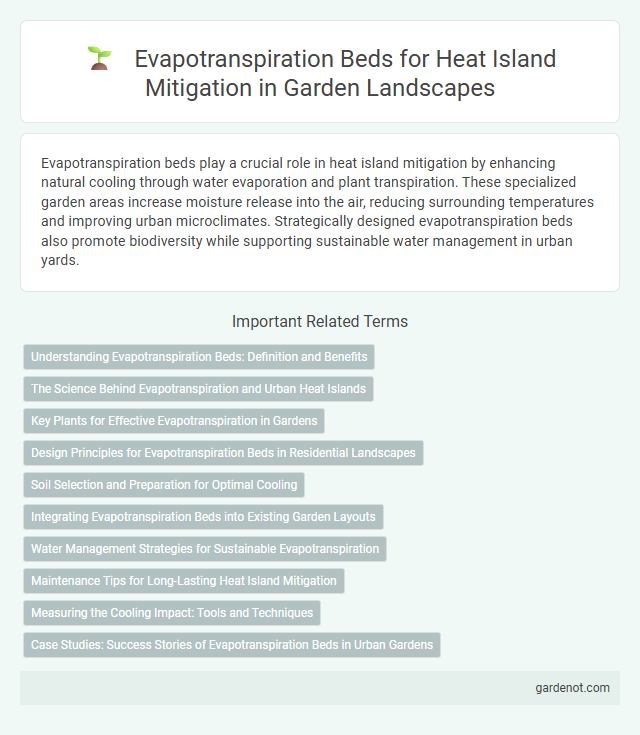Evapotranspiration beds play a crucial role in heat island mitigation by enhancing natural cooling through water evaporation and plant transpiration. These specialized garden areas increase moisture release into the air, reducing surrounding temperatures and improving urban microclimates. Strategically designed evapotranspiration beds also promote biodiversity while supporting sustainable water management in urban yards.
Understanding Evapotranspiration Beds: Definition and Benefits
Evapotranspiration beds are engineered landscapes designed to enhance natural water evaporation and plant transpiration, significantly reducing local temperatures in urban heat islands. These beds combine soil, vegetation, and moisture management to increase evapotranspiration rates, improving microclimate conditions and decreasing energy consumption for cooling. By promoting natural cooling processes, evapotranspiration beds support sustainable heat island mitigation strategies and improve urban environmental quality.
The Science Behind Evapotranspiration and Urban Heat Islands
Evapotranspiration beds reduce urban heat islands by utilizing the natural process where plants absorb water through roots and release it as vapor through leaves, cooling the surrounding air. This cycle lowers surface temperatures by increasing humidity and promoting evaporative cooling, counteracting heat absorbed by urban materials like concrete and asphalt. Scientific studies show that integrating evapotranspiration beds can decrease local ambient temperatures by several degrees Celsius, enhancing thermal comfort and reducing energy consumption in heat-affected urban areas.
Key Plants for Effective Evapotranspiration in Gardens
Key plants for effective evapotranspiration in heat island mitigation yards include native grasses, such as switchgrass (Panicum virgatum), and broadleaf species like cottonwood (Populus deltoides), which have high transpiration rates. Deep-rooted shrubs like elderberry (Sambucus canadensis) enhance soil moisture retention and promote continuous water cycling. These plants optimize evapotranspiration, reducing localized temperatures and improving urban microclimates.
Design Principles for Evapotranspiration Beds in Residential Landscapes
Evapotranspiration beds in residential landscapes optimize heat island mitigation by enhancing natural water evaporation and plant transpiration to cool surrounding air. Design principles prioritize selecting native, drought-tolerant plants with high transpiration rates and integrating permeable substrates for efficient water absorption and retention. Strategic placement in shaded or sun-exposed areas maximizes cooling effects while promoting biodiversity and sustainable stormwater management.
Soil Selection and Preparation for Optimal Cooling
Selecting well-draining, organic-rich soil enhances evapotranspiration efficiency by maintaining adequate moisture and root aeration in heat island mitigation beds. Proper soil preparation involves loosening compacted layers and incorporating compost or biochar to increase water retention and microbial activity. Optimized soil conditions promote plant health, maximizing cooling effects through increased transpiration rates.
Integrating Evapotranspiration Beds into Existing Garden Layouts
Integrating evapotranspiration beds into existing garden layouts enhances heat island mitigation by increasing local humidity and cooling through plant transpiration and soil evaporation. These beds use native, drought-resistant plants with high transpiration rates to maximize evaporative cooling while conserving water. Strategic placement near patios or pathways optimizes airflow and amplifies temperature reduction in urban green spaces.
Water Management Strategies for Sustainable Evapotranspiration
Evapotranspiration beds enhance urban heat island mitigation by optimizing water retention and promoting efficient water cycling through native vegetation and engineered soil substrates. Integrating rainwater harvesting and drip irrigation systems reduces runoff and maximizes moisture availability, supporting sustained evapotranspiration rates. These water management strategies improve microclimate regulation, decrease surface temperatures, and contribute to overall sustainable urban cooling solutions.
Maintenance Tips for Long-Lasting Heat Island Mitigation
Regularly inspect evapotranspiration beds for clogged or compacted soil to ensure optimal water absorption and evaporation rates. Maintain a diverse selection of drought-tolerant plants with deep root systems to enhance continuous moisture release and cooling effects. Seasonal pruning and soil aeration improve plant health and prevent stagnation, sustaining effective heat island mitigation over time.
Measuring the Cooling Impact: Tools and Techniques
Evapotranspiration beds significantly reduce urban heat island effects by cooling ambient air through water evaporation and plant transpiration. Measuring the cooling impact involves using infrared thermography to capture surface temperature variations and deploying microclimate sensors to monitor air temperature, humidity, and airflow around the bed. Advanced techniques like remote sensing coupled with computational fluid dynamics (CFD) models provide detailed assessments of thermal performance and cooling efficiency in heat island mitigation yards.
Case Studies: Success Stories of Evapotranspiration Beds in Urban Gardens
Evapotranspiration beds in urban gardens have demonstrated significant heat island mitigation by enhancing local microclimates and reducing surface temperatures by up to 5degC. Case studies from cities like Chicago and Tokyo report increased vegetation health and improved soil moisture retention, contributing to lower ambient temperatures and reduced reliance on irrigation. These successes highlight evapotranspiration beds as efficient green infrastructure solutions for urban heat island reduction.
Evapotranspiration bed Infographic

 gardenot.com
gardenot.com